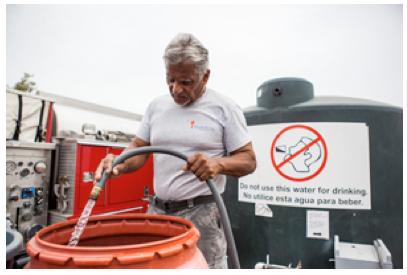CommentsWATER POLITICS--There is no public service used more often or more reflexively than drinking water. Every time we reach for the faucet handle, without even thinking about it, we expect clean, drinkable water to pour out. Sadly, this ritual has been betrayed for years by big corporations and lax oversight, right here in California -- with very little public attention or outrage.
Now, with the tragedy in Flint, the public and our state leaders are finally waking up.
In California, we have three main problems affecting clean water access for millions of Californians: a severe shortage of taps and fountains in schools, dried up wells no longer delivering water to homes in the Central Valley, and tainted water streaming out of faucets and shower heads in some of our most vulnerable neighborhoods.
Let's start with the most obvious -- making sure there's ample water where Californians live, learn and work.
Most of us remember the school water fountain as a central meeting place or a quick stop while racing to class. Well, believe it or not, thanks in part to residential and corporate "gluttons," water is dramatically scarce in California public schools. One in every four of California's nearly 10,000 schools doesn't meet state and federal requirements for providing drinking water.
So where do our kids turn when there's not enough water? You guessed it -- sugar-sweetened junk drinks. In California, 41 percent of children drink at least one junk drink every day, which increases their risk of obesity by 50 percent.
The problem with junk drinks is that liquid sugar is one of the most dangerous food substances that's legally available. Unlike fat and sugar in even a Snicker's bar, which takes the body hours to digest, liquid sugar gets absorbed in minutes, overwhelming the liver, which converts the sugar right into fat. Next comes fatty liver disease, a leading cause of diabetes.
We need to do more to make sure that kids can easily choose water over junk drinks. That means one or more fountains for every 25 students and free water in central school areas like the gym, the classroom and hallways.
Perhaps even more dangerous than spotty access to drinking water, is what amounts to easy access to tainted water.
Two areas with the highest concentration of struggling California families are the Central Valley and the Eastern Coachella Valley.
In Eastern Coachella, as many as 20,000 migrant workers live there year round. Their living conditions are abysmal, with crowded housing, electrical blackouts and pollution. Even worse, their water wells are tainted by naturally occurring arsenic.
Instead of providing residents with filtration systems so that people can safely bathe and drink the water that comes out their faucet, they have to go to local convenience stores to purchase clean water.
In the Central Valley, some of the poorest residents in unincorporated communities have found wells have run dry because the aquifers and other water sources have been depleted by the agricultural industry and water bottlers. These are families that struggled before the drought. Now, they have to truck water in to bathe or drink. Ironically, it's often the farm workers employed by the agricultural industry who are suffering the most.
California is famous for its agricultural bounty, active lifestyles and economic growth and innovation -- often the envy of the nation and the world.
It is time that we tackle the water crisis facing our state. It's the poor and vulnerable -- the same people hurt by income inequality -- who are suffering the most and that's not fair. Simply put, the water gap reflects the income gap that is hurting families across our state.
Ending inequality for struggling families means making sure that they have access to essentials like clean and abundant water as well as a fair and living wage. It's time to turn on the tap of equality for every Californian.
(Daniel Zingale is Senior Vice President for policy, communications, and public affairs at the California Endowment. This piece was originally posted at Huffingtonpost.com.) Photo: MotherJones. Edited for CityWatch by Linda Abrams.














